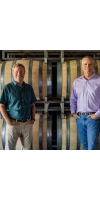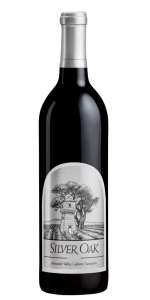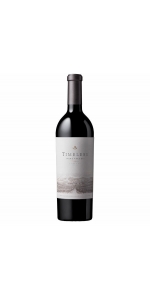Wine from Silver Oak

Ray Twomey Duncan, a Colorado entrepreneur who began investing in California vineyards in the late 1960s, and Justin Meyer, a Christian Brothers-trained winemaker, co-founded Silver Oak out of a Napa Valley dairy barn in 1972, producing only 1,000 cases of their inaugural vintage.
Silver Oak began over a handshake between two friends with a bold vision: focus on one varietal, Cabernet Sauvignon, aged exclusively in American oak and worthy of cellaring for decades to come.
In 2006, a fire destroyed our historic Oakville winery. While rebuilding was a difficult and emotional event; the opportunity to design a new, state-of-the-art winery from the ground up has resulted in better Napa Valley Cabernets and minimized our eco footprint.
Ten years after the fire, Silver Oak Napa Valley was designated the world’s first LEED Platinum winery for existing buildings, operations and maintenance (EBOM) by the U.S. Green Building Council (USGBC).
Next, when it came time to reimagine the Silver Oak Alexander Valley winery, we applied the lessons learned from our Oakville winery and set an even higher bar. With a goal of net-zero water and energy as our north star, the new Sonoma county winery has since become the world’s first winery to achieve LEED Platinum for building, design and construction (BD+C).
“We have yet to make our best bottle of wine,” or the idea that our best wines are still ahead of us, is a founding philosophy that still guides us to this day.
We farm more than 400 acres of vines in Napa Valley and Alexander Valley with a leading-edge approach toward farming and viticulture, and the softest possible impact on natural resources and the environment.
Since 2014, Napa Valley native Nate Weis has overseen all grapegrowing and winemaking operations at Silver Oak. Nate worked side-by-side with his predecessor Daniel Baron, just as Daniel worked with Justin Meyer before his retirement. These overlapping tenures ensure consistency and quality control, as well as the inherent wisdom that our best wines are still ahead of us.
Silver Oak Alexander Valley Cabernet Sauvignon is made from 95.2% Cabernet Sauvignon, 2.5% Cabernet Franc, 1.9% Merlot, 0.4% Petit Verdot
The Silver Oak Alexander Valley Cabernet Sauvignon 2019 has notes of red cherry, raspberry, blackberry, iris, vanilla and clove. Ruby in color, this elegant wine has great acidity and lift on the mid-palate. Black currant and warm baking spices linger with a deep and fruity finish. It will provide drinking pleasure through 2047 given proper cellaring.
Review:
Silver Oak's 2020 releases of Napa and Alexander Valley Cabernets are downright impressive. Tasted four years after the fires, in September of 2024 at the Alexander Valley winery, neither wine showed any sign of the hardened tannic structure or overwrought fruit often associated with the vintage. Instead, these wines remain true to Silver Oak’s signature style, with blackcurrant, fig, and plum fruits layered with white pepper, sweet cedar, and coriander spice. Medium-bodied, with sculpted tannins that persist through the lengthy finish, the Alexander Valley Cabernet in particular retains all the hallmarks of a balanced, inviting, and vibrant Silver Oak red.
-Decanter 94 Points
Truly gorgeous, fruity, velvety and enjoyable for a full-bodied cabernet. It is rich in blueberries, cherry cream, black cherries and raspberries on the palate, with very smooth, layered tannins and a soothing mouthfeel. So easy to drink now, but it will age well, too.
-James Suckling 94 Points
When the founding fathers of the Napa Valley carved out new sub-AVAs (American Viticultural Areas) in the 1980s, Soda Canyon Ranch was not yet on anyone’s map. The vineyard is neighbored to the northwest and west by the winegrowing districts of Stags Leap District and Oak Knoll District, respectively, which were among the early pioneers of California Cabernet Sauvignon to attain global fame. To the northeast and southeast—and further off the beaten path—were Atlas Peak and Coombsville, thought to be the next frontiers for the emerging wine-producing region.
This opulent wine has a broad and balanced mid-palate, notes of vanilla and blueberry, a dried floral character and chalky tannins. Anise and cherry lift the palate to a beautiful, lingering finish. In both aromatics and palate, this is an elegant vintage worthy of cellaring for years to come.
The winter of 2019 was marked by cold, foggy days in Napa Valley. Well-drained soils of Soda Canyon Ranch and steady, purposeful farming decisions mitigated the rainy and wet conditions as they persisted into spring. After months of ever-shifting weather, the vines were greeted by a consistent, warm and dry summer plus a mild harvest season, resulting in bright and ethereal fruit. Once blended, the 2019 vintage rested in French oak barrels for 16 months.
- back
Selected Options
Wineries
Categories
Pricing
Countries
Regions
Grape Types
Wineries
Organic/Free Shipping
Sourced from a vineyard at 505 metres above sea level in San Vicente de la Sonsierra, the wine takes its name from the site it is located on. The soils are primarily composed of depleted limestone in the subsoil and pebbles on the topsoil. These types of soils offer long-ageing capacity, freshness, volume and structured wines.
Fresh, structured and complex, this wine is very aromatic, with intense aromas of wild black fruits, accompanied by deep balsamic aromas and licorice. A silky texture and mineral notes, it is round, powerful and polished on the palate with flavors of black fruits, prunes, balsamic and spice. A long and persistent finish.
Meat and game, either grilled, baked or stewed, pastes, creams and soups, all kind of meat recipes, roast lamb.
Review:
"Dark plums, wild berries, dried herbs and warm earth with sweet spices and discreet vanilla creaminess interwoven to the nose. A medium-to full-bodied tempranillo with chalky, calculated tannins and vivid acidity. Lively, with a bright core of fruit on the center-palate and a flavorful, spicy finish. Naturally concentrated, but extremely drinkable, too. Long and bright. Drink or hold."
- James Suckling (September 9th 2022), 95 pts
Argot Simpatico Ranch Chardonnay is made from 100 percent Chardonnay.
Powerful aromas of key-lime, white flowers, orange blossoms and a fierce, flinty, sauvage note define a wildly complex nose. Once in the mouth, gracefully pronounced textures coat the palate delivering an exotic interpretation of cool-climate Chardonnay character — lime peel, orange blossom, ginger and clove —lingerings deep into a vibrant finish.
Planted 1978. Shallow volcanic soils on the gently-sloped, south-facing foothills of Bennett Peak on Bennett Valley’s floor. One of California’s coolest Chardonnay vineyards. In the final year of 3-year draught cycle, Simpatico Ranch saw its earliest ever harvest and smallest crop, exposing a reserve of exoticism and minerality previously untapped. A watershed vintage for both the vineyard, and appellation. Night harvested by hand on 9/16, whole-cluster pressed direct to barrel; no settling to ensure maximum lees contact. Barrel fermented on heavy lees. Malolactic fermentation. 16 months in French oak, 50% new. Finished 2 months in steel tank, low Sulphur during barrel elevage.
Review:
The 2022 Chardonnay Simpatico Ranch comes bounding out with exuberant notes of juicy peaches, ripe yellow apples, and persimmons, followed by hints of fresh ginger and toasted almonds. The medium to full-bodied palate is soft spoken and savory with a creaminess to the texture and lovely freshness defining the long whispery finish.
-Wine Palate 96 Points






